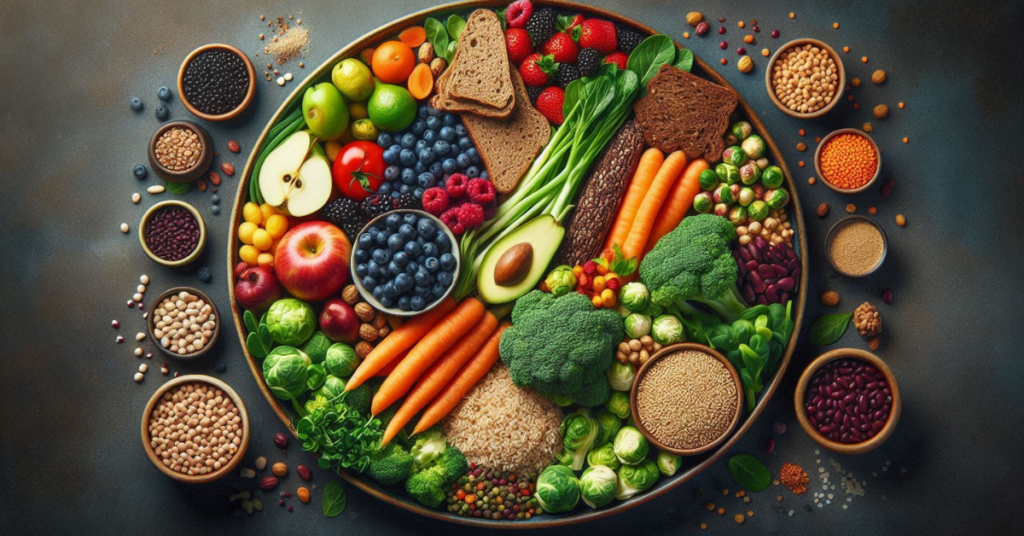Healthy Diet, Happy Life: A Guide
A healthy diet is the groundwork for remaining healthy and obtaining suitable nutrients. Firstly, it must involve ingesting a mix of the right foods. Additionally, it should uphold them in proper proportions while balancing the energy taken in and the energy expended. This report primarily focuses on synthesizing information from various sources to provide a clear vision of a healthy meal, its advantages, and the diverse diets and cultural practices in many countries. Consequently, these variations will be considered here. In summary, the critical components of a healthy diet will be explored.
Variety and Balance
A healthy diet requires eating a variety of foods to ensure the intake of essential nutrients. This includes a mix of vegetables, fruits, whole grains, and proteins from plant and animal sources. Consuming a diverse range of foods helps provide the necessary vitamins, minerals, and nutrients the body needs to function correctly.
Limiting Harmful Substances
Reducing the intake of harmful substances such as salt, sugar, and unhealthy fats is crucial. For instance, keeping salt intake to less than 5g daily can help prevent hypertension and reduce the risk of heart disease and stroke. Similarly, sugars should represent less than 10% of total energy intake to avoid health issues like obesity and diabetes.
Importance of Fiber

It is recommended that meals be based on higher-fiber starchy carbohydrates. Whole grains and high-fiber foods aid digestion and help maintain a healthy weight. Fiber also reduces the risk of chronic diseases such as heart disease and type 2 diabetes.
Hydration
Staying hydrated is an essential part of a healthy diet. Water should be the drink of choice, and it is important to avoid sugary beverages. Proper hydration supports overall bodily functions and can aid in weight management.
Regular Meals
Eating regular meals and not skipping breakfast is essential for maintaining energy levels and preventing overeating later in the day. Regular meals help maintain a stable metabolism and provide consistent energy throughout the day.
Health Benefits of a Healthy Diet
Heart Health
A healthy diet significantly reduces the risk of heart disease and stroke. Diets rich in vegetables, fruits, whole grains, and lean proteins can improve cholesterol levels, reduce blood pressure, and manage body weight. The DASH diet emphasizes these food groups and has improved cardiovascular risk factors.
Reduced Risk of Chronic Diseases
Consuming a healthy diet lowers the risk of developing chronic diseases such as diabetes, certain cancers, and neurodegenerative diseases. For example, a diet high in fruits and vegetables is associated with a lower risk of obesity and related diseases.
Improved Mental Health
A healthy diet can also enhance mental health by improving mood, memory, and sleep quality. Nutrient-rich foods support brain function and can help in managing stress and anxiety.
Weight Management
Maintaining a healthy diet is critical to achieving and sustaining a healthy weight. It involves balancing calorie intake with physical activity and choosing nutrient-dense foods over nutrient-poor options.
Bone and Dental Health
A diet abundant in calcium and vitamin D is essential for maintaining strong bones and teeth. Excellent sources of these nutrients include dairy products, leafy greens, and fortified foods.
Tailoring a Healthy Diet to Your Needs
While general guidelines provide a foundation, it’s essential to tailor your diet to your needs and circumstances.
- Dietary Restrictions and Preferences: Consider vegetarian, vegan, gluten-free, or allergy-friendly options when planning meals.
- Cultural Considerations: Embrace the diversity of global cuisines while adhering to healthy eating principles. Many cultures offer delicious and nutritious dishes that can be part of a balanced diet.
- Life Stages: The nutritional requirements shift according to different stages of life. Children, pregnant women, older adults, and individuals with specific health conditions may require tailored dietary advice. Seek advice from a healthcare expert or certified dietitian for tailored nutritional recommendations.
Practical Tips for Maintaining a Healthy Diet
Start Slow and Make Small Changes
Gradually incorporating healthy foods and making small changes can make sticking to a healthy diet easier. For example, swapping sugary snacks for fruits or choosing whole grain options over refined grains can make a significant difference over time.
Use Technology and Resources

Many online resources and apps help track food intake, find healthy recipes, and plan balanced meals. These tools can provide support and motivation to maintain healthy eating habits.
Listen to Your Body
Paying attention to hunger and fullness cues can help avoid overeating and make healthier food choices. Eating when hungry and stopping when full rather than eating out of boredom or stress is essential.
Avoid Gimmicks
Avoid fad diets, detoxes, and cleanses, as they are often unsustainable and can be harmful. Instead, focus on long-term, balanced eating habits rather than quick fixes.
Conclusion
A healthy diet is a cornerstone of overall well-being, offering numerous physical and mental health benefits. By embracing variety, limiting harmful substances, and prioritizing nutrient-rich foods, you can embark on a journey toward a healthier and more vibrant you. Additionally, consider your individual needs and preferences, and don’t hesitate to seek guidance from healthcare professionals or registered dietitians for personalized advice.
For Information: How to Manage Resources Step-by-Step: A Guide
